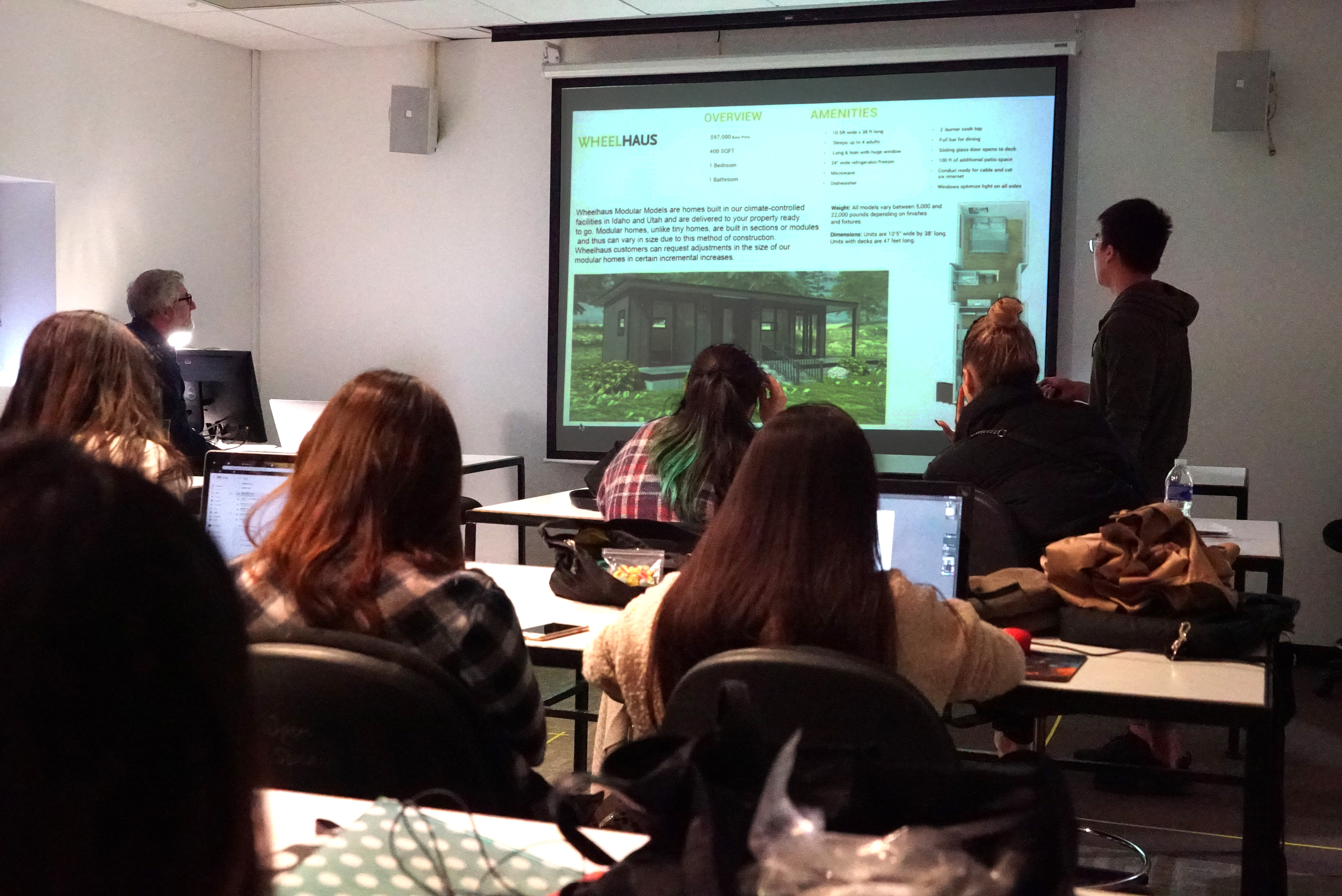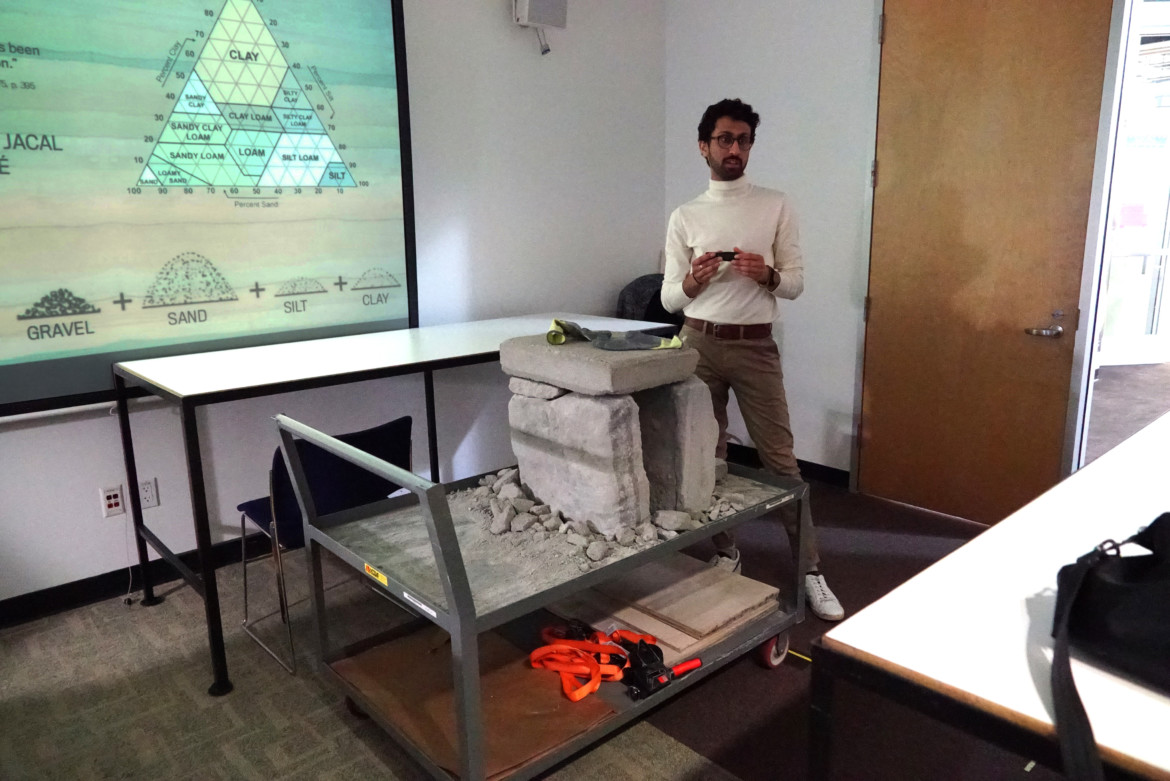Rooftop gardens and eco-conscious designs dominate student projects in Michael Sammet’s sustainable design class
By Kyle Roe
An eco-conscious property developer turned Academy of Art University instructor, the School of Interior Architecture & Design’s (IAD) Michael Sammet brings a lot of skill and experience to the table that’s both aesthetically pleasing and relevant to today’s pressing issues.
Sammet passes on his environmentally friendly expertise through IAD 380: Sustainable Design, a course requirement for students working towards a B.F.A. in IAD. Sitting in on his class is like peeking into the future of urban design. If Sammet’s—and his students’—vision of interior architecture takes hold, it’ll be a lot less grey and a lot more green.
A striking common theme tying together most of the students’ presentations was the addition of gardens planted on the exteriors of their buildings. Sometimes supplementing rooftop gardens, they help absorb heat normally stored in roads and buildings, mitigating the effects of pollution and increasing air quality.
Some students addressed housing issues faced by survivors of the Camp Fire in Butte County, California. Third-year student Bastian Tandean focused his entire project on designing affordable housing for those affected by the wildfire, which burned over 153,000 acres and claimed 86 lives.
Tandean outlined a plan for tiny modular houses after completing a case study on an environmentally focused apartment complex in Austin, Texas. “The project [in Austin] is all-sustainable,” Tandean explained. “It also contains the largest public art project for solar panels. It’s a huge housing project for 6,000 homes.”
His own project’s goals are centered around economic involvement and feasibility, affordability, and sustainability. The refabricated one-bedroom, one-bathroom houses are priced at $100,000 per unit, far below the $554,760 median sale price for California homes. Each house would have its own rainwater harvesting system to save on water and would be built out of sustainable materials, like bamboo, banana fiber, coconut husks, mushroom skin, and “100 percent fire-resistant” jesmonite walls. Like many of the projects, Tandean’s design included a rooftop garden.
Yujia Let’s project was centered around residences as well. Her biophilic studio apartments sought to mediate the effects of climate change by infusing nature into urban personal living spaces. “I’m designing this apartment for people like us. People working in the city,” Let explained. “So, you have this apartment where people have less living space, but more space for nature.”
The ninth and tenth floors are dedicated to a garden, complete with a swimming pool, and there is a vertical garden as well. Let’s case study of a vertical garden in Milan highlighted their environmental benefits, as they provide a habitat for animals and absorb carbon dioxide. The vertical garden is spread evenly into every studio apartment’s space, “so every studio apartment can have one or two pieces of the vertical garden,” Let said. The proposed location: 1000 Chestnut Street, in affluent Russian Hill.
Other students focused on redesigning the interior of existing San Francisco businesses, Maria Gudaylena’s sustainable dining project, which rethought the interior of classic San Francisco seafood restaurant Scoma’s. Food preparation techniques and the elevated need to re-supply due to waste also factor into climate change calculations.

Students review a slideshow during a class in IAD 380: Sustainable Design. Photo by Bob Toy.
“So much work goes into making the food, in terms of energy and water, and we waste like 30 percent,” Sammet added.
Gudaylena didn’t have to search far for the subject of her case study. She decided to research Bar Agricole in SoMa, a tavern and Californian restaurant that won the James Beard Foundation’s Outstanding Restaurant Design award in 2011.
According to the American Institute of Architects: “Designed to complement to the restaurant’s seasonal menu, sourced from a local network of sustainable farms and gardens, the interior palette balances warm textures with the use of durable, sustainable materials.”
Scoma’s already sources from local fisherman, eliminating a lot of transportation costs money- and energy-wise. However, there is still a lot of room for improvement. “They have very low ceilings, and very little light,” Gudaylena explained. “Also, their window is facing north. Not only are they not getting direct sunlight, the roof is sloped in a way that’s always in a shadow.”
“For my goal, I decided to aim towards Zero Energy Certification and LEED,” Gudaylena said. “Reducing food waste, making all the appliances energy efficient, including lighting [and] conserving water better.”
All of the students’ projects offer real-life solutions geared toward increasing sustainability in a variety of urban building categories. The Academy’s curriculum is largely geared toward navigating and succeeding in real-world professional environments, and sustainable design does this while pushing students to consider environmentally friendly design methods.
